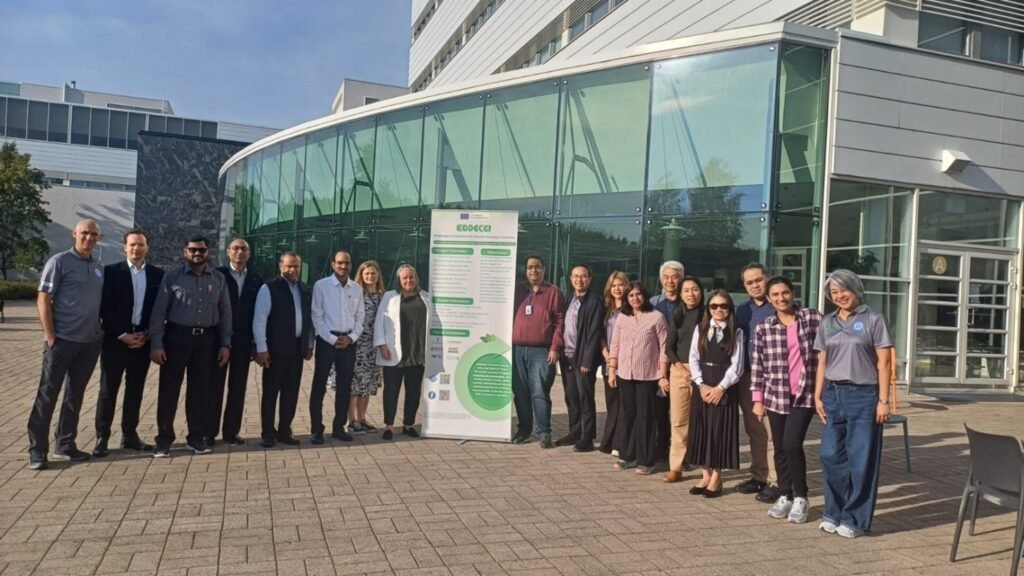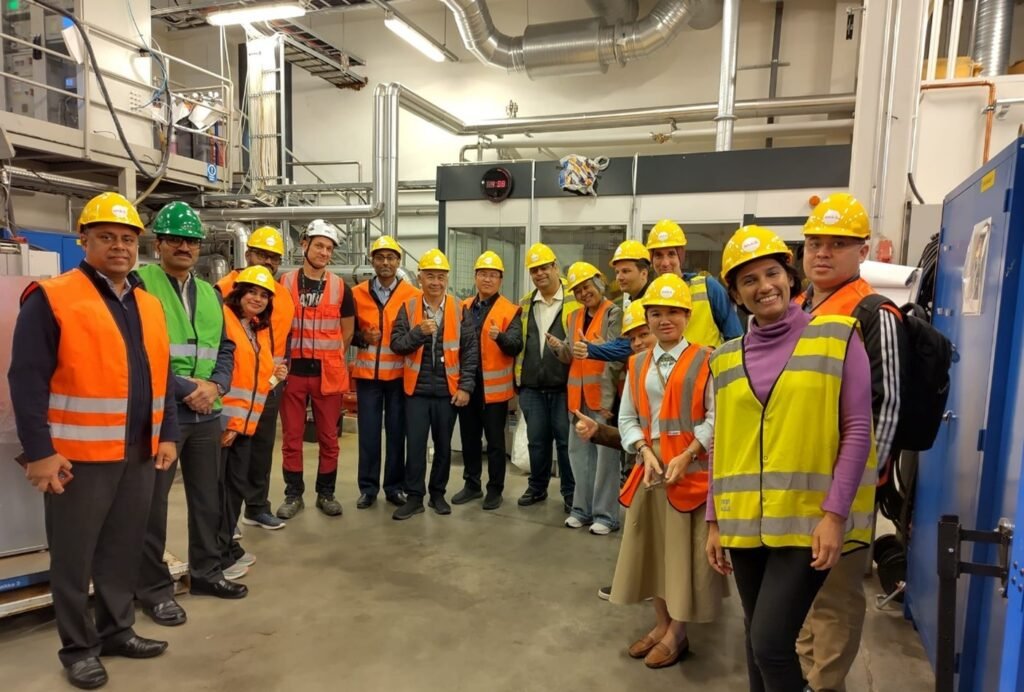Advancing Sustainable Circular Economy Education: Insights from KODECET’s September Project Meeting

The KODECET project partners met in person in the sunny and unexpectedly warm mid-September weather in Jyväskylä University Finland. In this blog I wanted to share my reflections and insights from the meeting and our work in advancing Sustainable Circular Economy Education.
Reflections on the Journey
Celebrating the process of collaboration towards a sustainable future
They say that “It’s not the destination, it’s the journey” This famous quote is attributed to Ralph Waldo Emerson the American philosopher. “Enjoying the journey, ‘the getting there’, is every bit as important to me as arriving at the destination.” The quote is often cited perhaps for it serves many purposes. I can relate to it also in the context of project work. The project KODECET aim is clear, and our partners are all striving towards it relentlessly and with enthusiasm. How ever, I believe that the process – or the journey of working together creating solutions for more sustainable future with academics and professionals from different fields and diverse cultures is well worth celebrating. Our project meeting last month is just the kind of moment along the project journey where it’s good to stop and reflect for a minute.
The second live project meeting brought together our consortium of six universities from four countries for catching up on where we stand. Over the course of three days, we had excellent discussions regarding the curriculum and syllabus for courses we are creating to promote SACE principles, as well as the project’s next steps. We reached a solid understanding of key content, with surprising ease, considering the diverse cultures and educational systems we need to integrate our curriculum to.
Our partners were welcomed to the campus by our Dean at Jyväskylä School of Business and Economics (JSBE), Hanna-Leena Pesonen. As her professorship is in Corporate Environmental Management, her expertise in sustainability transitions gave our project meeting a fitting start.

Industry Insights from Central Finland
Innovative companies like Tana Oy, Betolar Oy, and 2Loops share sustainability breakthroughs.
When organizing the event, we had contacted selected companies in Central Finland, whose Circular Economy (CE) operations we thought would serve us as inspiring examples in our work creating curriculum and course materials that are thought provoking and motivational for future CE leaders and professionals.
Circular Economy Action
Exploring cutting-edge solutions in waste management and sustainable construction materials.
We had the opportunity to enrich our knowledge and experience about CE with 5 presentations from different organisations operating in different fields and levels of sustainability and circularity. The variety of business and organisations from different sectors helps to draw a holistic picture of Circular Economy. All the companies are local to Central Finland and most of them act globally. For innovations in technology, we appreciated the talk from CEO Kalle Saarimaa and Quality Manager Jarkko Hirvonen from Tana Oy. We were truly inspired by the founder of Betolar Oy, Juha Leppänen’s exceptional creativity and ability to think outside the box.
Tana Oy as a provider of technology for the waste shredding, and separating, is an essential operator in enabling material cycles. When a product, say a car tire, has served its life and is to be made into a new kind of product, the material first needs to be shredded into small particles. After shredding, the tire material can be used as a substitute for new raw materials, such as plastics and rubber for shoe soles and other goods giving the material an extended life.
Sustainability Beyond Technology
policy, mindset shifts, and social engagement are key to Circular Economy success
Visiting Betolar Oy in Kannonkoski allowed us to peak into the laboratory where more sustainable construction material recipes are created using side streams of other industries. Side streams are often considered waste or residual materials, but in CE context, side streams are valuable resources. As construction materials and cement used to make concrete are a significant cause of emissions in the industry, substituting cement with a byproduct or secondary flow of materials generated during a production process makes a consequential difference. Technological innovations are important for industries in material cycles, raw material substitutes and material efficiency. How ever, in our discussions the leaders of these fore runner CE technology companies stress that technology alone is not the answer for successful sustainable Circular Economy. Juha Leppänen determines that transition to CE requires policy change for faster deregulation and a lighter approval process for new materials and solutions. Behind successful sustainable Circular Economy is the ability to change the way we think but also ability to change the way we act. The actions of organisations depend a lot on local and global policy and could be encouraged towards circularity and sustainability with properly aligned policy.
Collaborative Learning and Global Perspectives
Mutual learning experiences and workshops connecting global Circular Economy students
Motivated by a vision for a sustainable future, Juha Leppänen, the founder of Betolar, sought alternatives and created an entirely new concept and business model that is proving to be strong part of sustainability transition. In light of this commitment to sustainability, we were privileged to attend a presentation and engage in a lively discussion with our guest speaker, Tiina Hirvanen, one of the founders of 2loops, a local service design company focused on circularity and sustainability. We enjoyed vivid exchange of thoughts with Tiina. The contribution of Tana Oy and Betolar Oy in the Circular Economy production value chain are very concrete and tangible while as a service design company, I see 2Loops’s contribution to sustainable Circular Economy as bridging the gap between different actors and levels of society, citizens, policy makers and companies. Their pilot projects involving cities and NGOs to promote behavior change and explore ways for cities and companies to facilitate this process, are particularly important in Europe, Finland included. The relevance, if someone would overlook the essential point, becomes clear when re-focusing the perspective. Because of the scale of population, comparing Finland (Population of 5,5 million) and India (population of 1.4 billion) at the nation level, is not relevant. If comparing the nations the scale needs to balance, and we are considering Europe compared to India. Looking at the statistics at the individual level reveals quite clearly that here in Europe and in Finland we still have a lot of work on reaching sustainable levels while on the other side of the globe, we need to ensure that well being and economic sustainability does not throw these nations and their citizens down the same destructive path experienced by Europe.
Successful transition to sustainable Circular Economy requires involvement of citizens in coproduction. By this I mean that organisations, both public and private should work with citizens in finding out ways to create more sustainable ways of living. Ultimately, we are talking about finding other essences in life than the current consumption orientated culture is offering us. Workshops and pilot programs like 2loops’s, aimed at strengthening sustainable work and lifestyles, are also common in India and Thailand. In these regions tradition and cultural heritage provides valuable insight and ways for sustainability. Considering these aspects one of the outcomes of the discussions was the proposal for a mutual learning experience for global Circular Economy students. A crucial aspect of sustainability is ensuring the right to a good standard of living. To be able to ensure this also for the future generations of people and other living beings on earth, a linear approach to economic development cannot provide a viable solution.
Our schedule included a visit to BioBoosters in the Jyväskylä university of Applied Sciences in Tarvaala, Saarijärvi. The BioBoosters project aims at accelerating Circular Economy through international Hackathons. The project KODECT has also committed 80 participants to foster university-business collaboration. We engaged in fruitful discussions about potential global collaborations with Riikka Kumpulainen and Annimari Lehtomäki.

Nature reciprocity and Sustainability at Könkkölä Green Care Center
Nature-based learning fosters ecological and social sustainability in Circular Economy
Our intensive Project days ended in a regenerative environment of Könkkölä Green Care Center, a social enterprise dedicated to rehabilitative activities for social and ecological sustainability in form of regenerative gardening, and ecopsychology methods. Executive director of Könkkölä, Taiga Rautiainen emphasized the importance of nature reciprocity and hands on learning in empowerment and the connection between social enterprises, environmental stewardship, and community health. For me, as a gardener and researcher, Taiga’s words gave a sense of hope that sometimes eludes me in the midst of slow and fragmented social change for sustainability.

The visits to and presentations of the five very different kinds of organisations acting for sustainability with Circular Economy methods, spurred a spectrum of thoughts about enablers of the Circular Economy at different levels of society leading to paradigm shift that is essential.
The Road Ahead for Circular Economy Education
Balancing economic, environmental, and social dimensions for a sustainable future
Circular Economy phenomena has developed strongly through practitioners and policymakers’ initiatives. The companies highlighted here are undoubtedly frontrunners in their field; however, the overall progress of CE development does not seem to be achieving its primary objective of sustainability. As a tool for the sustainable transformation of the economic system, a CE framework on which to reflect business operations and politics is also called for. A framework could enable more coherent transformation.
The key takeaway from the example companies for us developing higher education for the future CE leaders, is the importance of strengthening versatility of skills and competencies and the integration of strong sustainability perspective into operations and actions. According to CE researchers the expectations of companies acting in CE are commonly mainly economic and business oriented. Some leading organisations however have acknowledged the transformation concept and are actively working towards a more sustainable future including environmental and social well-being, reaching also economic sustainability.
To conclude, I would like to reflect on this very pillar of sustainability in CE context. Increasingly, researchers assert that decoupling economic growth from the consumption of natural resources is not possible. The emphasis on Circular Economy should extend beyond merely reducing the use of virgin raw materials and increasing efficiency; it must also focus on significantly decreasing overproduction and consumption. Our current economic system relies heavily on finite resources extracted from the Earth, and this capacity is rapidly running out. It is vital to recognize that true economic sustainability cannot be realized without a planet capable of supporting life. Therefore, rethinking our narrative from traditional notions of economic growth through CE, towards a framework centered on economic sustainability for planetary well-being through CE practices.
Sirpa Kortelainen
Project KODECET
Project researcher
University of Jyväskylä
Sirpa.a.kortelainen@jyu.fi